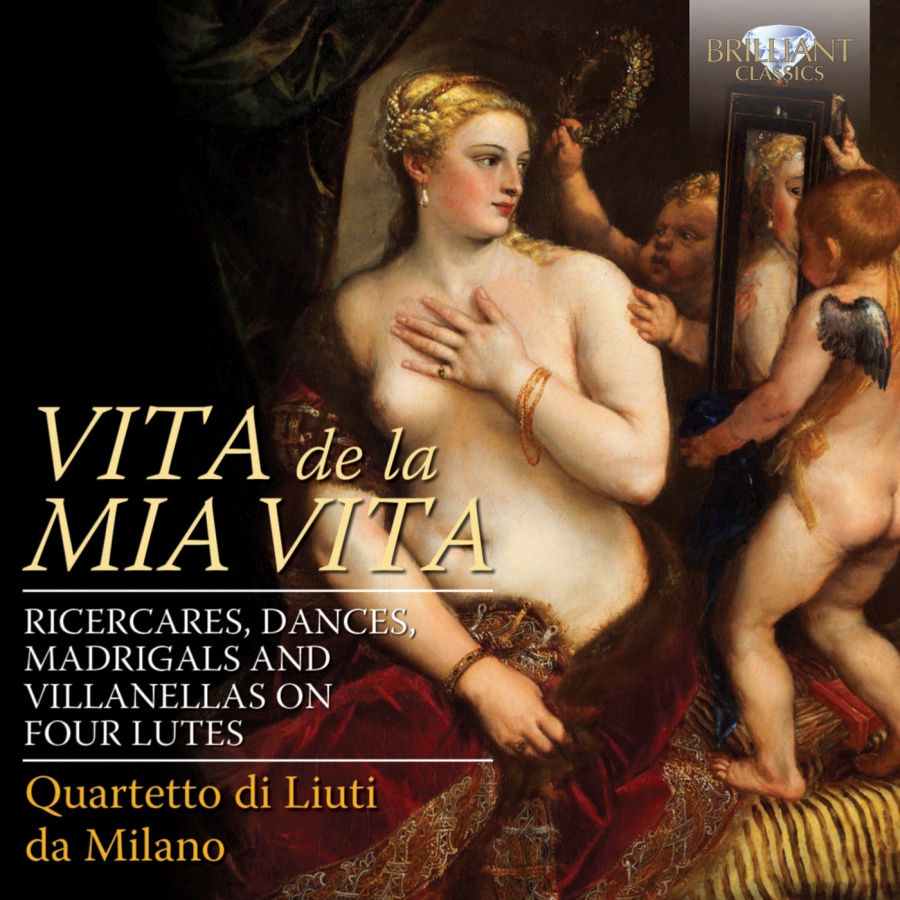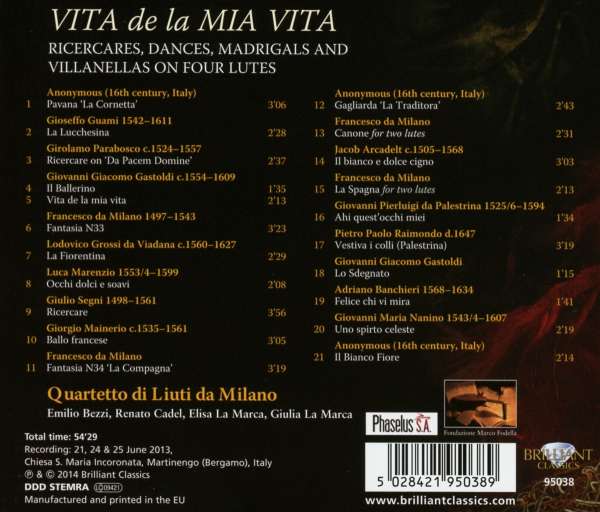
tytuł
Vita de la mia vita: Ricercari, Dances, Madrigals and Villanelle on Four Lutes
wykonawcy
Quartetto di Liuti da Milano
nr katalogowy
95038
opis
A celebration of Italian Renaissance lute music, this release showcases a variety of composers, from the well known (such as Palestrina and Da Milano) to some now faded into obscurity, and introduces the listener to all forms of lute music that were in vogue during that period: ricercares, dances, madrigals and villanellas. The innovation to be found in this music is extraordinary: instrumental music from this period was designed to imitate the human voice, evident in many of the pieces included here, with intricate polyphony echoing the vocal madrigals, and eversophisticated ways of writing in turn led to new forms (the ricercar and canzona), creating a new type of instrumental language. The line between vocal and instrumental music thus became far more blurred in this period: it was even common for vocal works, such as madrigals, to be played rather than sung. The lute consort, the focus of this release, was one of the highest courtly expressions of ensemble
music, best revealing the potential of the instrument and offering a voiced reconstruction of one of the most exclusive ambiences of ancient palaces.
• anon.: Il bianco fiore
• anon.: La Traditora
• anon.: Pavana 'La Cornetta'
• Arcadelt: Il Bianco e Dolce Cigno
• Arcadelt: Madrigali, Book 1
• Banchieri: Festino nella sera del giovedì grasso avanti cena, Op. 18, No. 15 'Li fusari cantano un madrigale 'Felice chi vi mira'
• Canova da Milano: Canone for 2 lutes
• Canova da Milano: Fantasia (33) sopra mi-fa-mi
• Canova da Milano: Fantasia (34) ‘La Compagna’
• Canova da Milano: La Spagna
• Gastoldi: Il Ballerino
• Gastoldi: Lo Sdegnato
• Gastoldi: Vita de la mia vita
• Guami: La Lucchesina a due cori
• Mainerio: Il Primo libro di Balli
• Marenzio: Occhi dolci e soavi
• Nanino, G M: Uno spirto celeste
• Palestrina: Ahi quest'occhi miei
• Parabosco: Da Pacem Domine
• Parabosco: Il ballerino
• Raimondi, P P: Vestiva i colli (Palestrina)
• Viadana: La Fiorentina
Works:
• anon.: Il bianco fiore
• anon.: La Traditora
• anon.: Pavana 'La Cornetta'
• Arcadelt: Il Bianco e Dolce Cigno
• Arcadelt: Madrigali, Book 1
• Banchieri: Festino nella sera del giovedì grasso avanti cena, Op. 18, No. 15 'Li fusari cantano un madrigale 'Felice chi vi mira'
• Canova da Milano: Canone for 2 lutes
• Canova da Milano: Fantasia (33) sopra mi-fa-mi
• Canova da Milano: Fantasia (34) ‘La Compagna’
• Canova da Milano: La Spagna
• Gastoldi: Il Ballerino
• Gastoldi: Lo Sdegnato
• Gastoldi: Vita de la mia vita
• Guami: La Lucchesina a due cori
• Mainerio: Il Primo libro di Balli
• Marenzio: Occhi dolci e soavi
• Nanino, G M: Uno spirto celeste
• Palestrina: Ahi quest'occhi miei
• Parabosco: Da Pacem Domine
• Parabosco: Il ballerino
• Raimondi, P P: Vestiva i colli (Palestrina)
• Viadana: La Fiorentina
nośnik
CD
gatunek
Muzyka klasyczna
producent
Brilliant Classics
data wydania
13-11-2019
EAN / kod kreskowy
5028421950389

(Produkt nie został jeszcze oceniony)
cena 55,00 zł
lubProdukt na zamówienie
Wysyłka ustalana indywidualnie.
Darmowa wysyłka dla zamówień powyżej 300 zł!
Darmowy kurier dla zamówień powyżej 500 zł!
sprawdź koszty wysyłki














